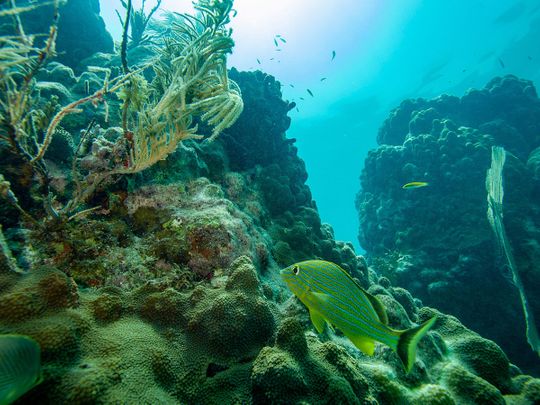
"Off the charts." "Disastrous." "The worst bleaching event that Florida has ever seen."
That's how scientists are describing the ecological disaster unfolding in the seas around the Sunshine State.
In recent weeks, a blistering marine heat wave has sent water temperatures off the coast of South Florida - home to the largest living barrier reef in the continental United States - skyrocketing to record highs, causing an extensive coral bleaching event.
The situation may get worse before it gets better, with much of the Caribbean projected to see coral-damaging temperatures in the coming weeks, according to the National Oceanic and Atmospheric Administration.
Here's what you need to know.
So what, exactly, is coral?
Good question. Is it a plant? An animal? The answer is: kind of both.
Scientists officially classify corals as a type of animal. But unlike most members of the animal kingdom, the thousands of polyps that make up a reef don't move around much, using tentacle-like arms to scoop up food drifting by. Rooted to the seafloor, scientists call coral sessile - that is, the opposite of mobile - animals.
But those little immobile animals have help. Plantlike organisms called zooxanthellae reside inside most coral.
It's a symbiotic relation: Corals provide these organisms nutrients as well as a nice, protected place to bask in the underwater sun. Like plants, zooxanthellae harvest energy from sunlight.
Corals, with their limestone skeletons, in turn use organic material from zooxanthellae to construct the elaborate, multicolored submarine cathedrals that draw legions of snorkelers and scuba divers.
The result: Together, the two help create some of the most beautiful and beneficial ecosystems on the planet.
What's happening to the coral in Florida?

While experts say the potential for a coral bleaching event wasn't unexpected this summer, the arrival of superheated ocean temperatures came earlier and have been more intense than most thought. Typically, the Florida Keys experience high temperatures in mid-August through early September, said Jessica Levy, director of restoration strategy at the Coral Restoration Foundation.
"What people are really worried about is the longer it lasts, the more damage you start to see," Levy said. "The fact that this happened in July and then we still have August and September, that's scary."
According to NOAA's alert scale for corals, the current conditions are in the most extreme category, known as Alert Level 2. These conditions are projected to remain for the next 12 weeks.
Scientists are observing widespread bleaching along parts of the roughly 360-mile-long reef. The hotter conditions are also affecting critical efforts to restore the embattled ecosystem. The Coral Restoration Foundation reported that 100 percent of the corals at one restoration site in the Keys are bleached and a majority have already died, said Alice Grainger, the group's senior director of communications.
"We're also seeing corals that have even died before they bleached," Grainger said.
What causes coral bleaching?
Corals are hardy, having existed on Earth for at least 500 million years. While reef-building corals prefer water that is between 73 and 84 degrees Fahrenheit, some can tolerate temperatures up to 104 degrees - at least for a short period of time.
But they can only endure the heat for so long. When the water is too warm for too lengthy a time, coral spit out their beneficial zooxanthellae, causing them to turn a deathly white. This is coral bleaching.
Despite their ghostly appearance, a bleached coral isn't necessarily a dead one.
"Bleaching does not equal death," said Jennifer Moore, a coral recovery specialist at NOAA.
"Corals are still alive when they bleach, and they can regain their algae that gives them their color and that gives them their food," she added.
But while coral can survive a bleaching event, they are under more stress and are more likely to die.
Why should I care about coral?
Even if you've never spent a vacation day snorkeling a coral reef, you may want to thank one.
For seaside residents, healthy reefs are a living buffer against coastal storms and erosion. A weak, dead one will be chewed up by the waves.
For seafood lovers, they're a crucial source of fish and lobsters. In fact, coral reefs support a quarter of all marine life.
The fallout from losing a coral reef remains frighteningly murky, Grainger said.
"That's the scary thing," Grainger said. "We know it would have extraordinary implications, but we just don't know how bad it would be."
Reefs may have even more to give - if they don't vanish entirely, that is. In recent years, medical researchers have extracted chemicals from coral to help make better antibiotics.
But for those who are passionate about coral, sometimes it's difficult to get others to care, too.
"It is a very hard thing to do," said Kim Stone, director of fish and invertebrates at the Georgia Aquarium.
"Any animal that doesn't have a face or doesn't have eyes that you can look into, that you can associate with, is at times very hard to connect with," she added.
How can coral be saved?
The pace and scale of bleaching in Florida has triggered what many experts are calling an "all-hands-on-deck" scramble to save as many corals as possible and improve the chances that affected sections of reef can recover.
Two urgent efforts are happening at the same time, Moore said:
Scientific teams are collecting small fragments from genetically unique corals and storing them on land in gene banks, which is critical to prevent any losses of genetic diversity.
They are also rescuing healthy coral stock, which can be used to make more coral or be planted onto damaged reefs, from areas that are too hot and moving the pieces to facilities on land or into deeper, cooler water to wait out the heat wave.
Moore added that experts are also developing plans to safeguard corals that are still in the water. Some potential interventions, she said, include shading nurseries or high-value reef sites, and providing corals with more food through a process known as supplemental feeding.
Additionally, experts said it's important to reduce or remove local stressors that can further place further strain on the reef, such as runoff from land and overfishing.
What happens next?
In the longer term, experts said this bleaching event can provide crucial lessons about protecting and restoring the reef.
"There's a lot that we can learn," Moore said. "We would never just keep doing the same thing and expect a different result."
For instance, scientists may put a greater focus on breeding corals that are more resilient or resistant to heat or disease, she said. Other experts said there may be increased efforts to create more land-based nurseries.
But restoring reefs alone won't be enough. Drastic cuts to climate-warming emissions are needed. Not only does the buildup of carbon dioxide warm the atmosphere, but it also makes oceans more acidic and less hospitable for many marine animals.
According to one forecast, climate change may wipe out almost every coral reef habitat on Earth by the end of the century.
"Coral restoration is a critical part of the solution, but it's not the whole solution," Grainger said. "The solution needs to be action on climate change."











